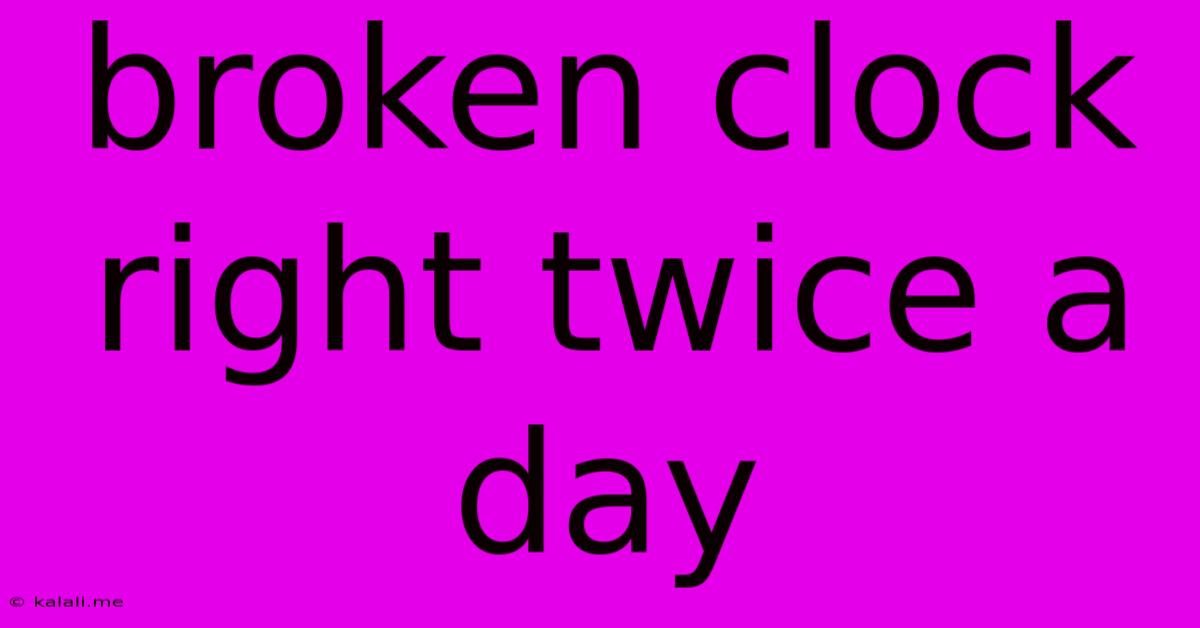Broken Clock Right Twice A Day
Kalali
May 27, 2025 · 3 min read

Table of Contents
The Broken Clock That's Right Twice a Day: A Deeper Look at Probability and Precision
This article delves into the fascinating adage, "a broken clock is right twice a day," exploring its implications beyond the surface-level meaning. We'll examine the underlying probability, the limitations of the statement, and how this seemingly simple observation connects to broader concepts in accuracy and precision. Understanding this concept can even help you better appreciate the importance of reliable data and timekeeping in various aspects of life.
A broken clock, assuming it still moves its hands albeit erratically, will eventually align with the correct time twice within a 24-hour period. This is a simple truth based on the fact that the hour and minute hands move independently, even if incorrectly. The statement, however, isn't a universal truth applicable to all forms of broken clocks. A clock completely stopped, for instance, will only be correct once a day. This highlights the crucial distinction between a randomly malfunctioning clock and one that is simply not functioning.
The Probabilistic Nature of Accuracy
The "twice a day" assertion relies heavily on probability. While it's statistically likely that a randomly malfunctioning clock will hit the correct time twice, it's not guaranteed. The statement's accuracy depends on the clock’s erratic movement. If the clock's hands move in a predictable, albeit incorrect, pattern, this could alter the frequency of accurate readings.
Consider a clock that consistently runs 12 hours fast. This clock will be accurate only once a day, at midnight and noon. On the other hand, a clock with completely random hand movements could potentially be accurate more than twice a day, although this is less probable. Therefore, the "twice a day" notion serves as more of a general probabilistic observation rather than an absolute law.
Beyond the Clock: Implications for Accuracy and Precision
The broken clock analogy transcends the simple realm of timekeeping. It serves as a compelling metaphor for situations where unreliable systems or data still occasionally produce accurate results by chance. Think about:
- Scientific measurements: A flawed experiment might, by pure chance, yield a correct result. However, relying on such a result without properly addressing the flaws in the methodology would be scientifically unsound.
- Statistical analysis: Random sampling can lead to accurate conclusions, but only if the sample size and methodology are rigorously designed. A small, biased sample might provide accidentally correct results, but those results are unreliable and shouldn't be generalized.
- Decision-making: An incorrect process might coincidentally lead to a correct decision, but this doesn't make the process valid. Repeating the same flawed process expects similar luck, which is unreliable and risks serious consequences.
The Importance of Reliable Systems
The broken clock's occasional accuracy highlights the critical importance of utilizing reliable, well-maintained systems. The reliability of any system, whether it's a clock, a scientific experiment, or a business process, is paramount. Relying on luck or coincidental accuracy is inherently risky and unsustainable in the long run. The pursuit of precision and accuracy requires consistent effort in building and maintaining robust and well-calibrated systems. A well-functioning clock, while not as exciting an analogy, is far more dependable and valuable than a broken one.
Latest Posts
Latest Posts
-
How To Write A Negative Dollar Amount
May 29, 2025
-
20 Amp Gfci On 15 Amp Breaker
May 29, 2025
-
Is A Brake Fluid Flush Really Necessary
May 29, 2025
-
How To Fix Crack Between Ceiling And Wall
May 29, 2025
-
How To Light A Gas Range
May 29, 2025
Related Post
Thank you for visiting our website which covers about Broken Clock Right Twice A Day . We hope the information provided has been useful to you. Feel free to contact us if you have any questions or need further assistance. See you next time and don't miss to bookmark.